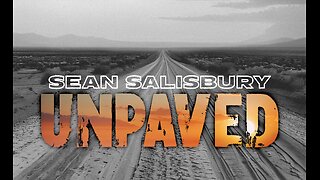Premium Only Content

Episode 3097: The New Mass: The Fracturing of the Sign of Peace and the Plumb-Line - Morning Episode
Nightly Zoom Coordinates for Rosary:
Meeting ID: 865 8978 0399
Passcode: Wjjv4960!
Speak Lord for your Servant is Listening
Book Recommendation of the Day
by Saint Augustine
1. The Confessions of Saint Augustine
o An autobiographical work detailing Augustine's sinful youth and his conversion to Christianity. It's considered one of the first Western autobiographies and remains a spiritual classic.
2. The City of God
o A monumental work defending Christianity against pagan critics, discussing the relationship between the earthly city and the City of God.
3. On Christian Doctrine
o A guide for interpreting Scripture and teaching Christian truth, emphasizing the importance of love in understanding and conveying biblical messages.
4. On the Trinity
o An extensive theological treatise exploring the nature of the Trinity, reflecting Augustine's deep philosophical and theological insights.
As is the case I need to give you something to think about before going into the episode for today and it’s a part of the mass called the Pax Domini or Peace of the Lord.
One of the more subtle yet profound ruptures introduced by the Novus Ordo Missae concerns the manner in which the "Pax Domini"—"Peace of the Lord" is expressed before the faithful receive Holy Communion. In the Traditional Latin Mass, the priest alone says, “Pax Domini sit semper vobiscum” (“May the peace of the Lord be always with you”), immediately before the breaking of the consecrated Host. This is not a casual greeting. It is a sacred moment, a liturgical act flowing directly from the Sacrifice of the Altar, and it is followed by no distraction. The priest, with hands still consecrated from the Canon of the Mass, proceeds directly to the Fraction Rite and Holy Communion. His hands remain un-touched, his focus fixed solely on the Holy of Holies.
In the Novus Ordo, this sacred gesture has been recast into a horizontal, social exchange. The priest now invites the faithful to “offer each other the sign of peace,” often prompting handshakes, hugs, waves, or even casual conversation. What was once a quiet, priestly invocation of Christ’s peace has become a moment of human interaction and emotional expression. The sacred silence is broken. The faithful shift their attention from the altar to each other, from the divine to the human.
Even more troubling, from a traditional viewpoint, is that the priest now often participates in this exchange, sometimes shaking hands with altar servers, deacons, and extraordinary ministers of Holy Communion. Traditionally, the priest’s hands, having just handled the consecrated Body and Blood of Christ, were to remain undefiled set apart until after the sacred distribution of Communion. The shaking of hands before distributing the sacrament introduces the risk of distraction, irreverence, and even liturgical inconsistency. It interrupts the sacred flow between Calvary and Communion.
This change is not merely a matter of gesture it represents a theological rupture. In the Roman Rite, every liturgical action is meant to communicate spiritual truth. The priest, as alter Christus (another Christ), is the mediator between God and man at the altar. The peace he imparts is the peace of Christ crucified and risen, flowing from the sacrifice just re-presented on the altar. When that peace is converted into a horizontal, communal gesture, it risks becoming a symbol of human camaraderie rather than divine reconciliation.
To evaluate this rupture, we turn to the plumb line the divine standard spoken of in the Book of Amos: “Behold, I will set a plumb line in the midst of my people Israel” (Amos 7:8). The plumb line measures deviation. It is a call to assess how far we have strayed from the divine architecture established by God. In the traditional Mass, every action, every silence, every rubric, was designed to conform precisely to that vertical standard of reverence and doctrine. The Mass was not built for creativity or comfort it was built to give glory to God and sanctify man in awe.
The innovation of the modern “sign of peace” illustrates a tilt away from that plumb line. It centers man, not God. It introduces a break in the sacred continuity that ought to lead from the Consecration to Communion in humble recollection. And by compromising the sanctity of the priest’s consecrated hands hands set apart to touch the Sacred Host this novelty further disorients the faithful and weakens belief in the Real Presence.
In times of confusion, we are called not to reinvent but to realign. The Church's path forward is not novelty, but fidelity to the doctrine, to the reverence, and to the sacred liturgy that has formed saints for centuries. It is time to once again hold up the plumb line, test our worship against it, and correct what is askew.
Now you knew I was also going to tie in the masonic influence. The Handshake of Peace: A Masonic Gesture in the Holy Mass?
From a traditional Catholic viewpoint, the introduction of the handshake as a "sign of peace" within the sacred liturgy is not only liturgically disruptive but also theologically and symbolically suspect. Among the most troubling concerns is the resemblance this gesture bears to Masonic ritual and ideology an influence the Church has long condemned.
The Freemasons have historically used the handshake as a secretive ritual symbol a gesture of fraternity, equality, and mutual recognition. These ideas are not incidental; they are foundational to Masonic philosophy. Their worldview centers on the brotherhood of man and rejection of hierarchical religion, particularly that of the Catholic Church. In fact, Freemasonry promotes a horizontal model of spiritual unity, one that explicitly denies the supernatural authority of the Church and the unique mediatorship of Jesus Christ through the priesthood and sacramental life.
In contrast, the traditional Catholic Mass is hierarchical and vertical—it directs worship from man to God through the priest acting in persona Christi. The sacred liturgy is ordered toward divine adoration, not human fellowship. Inserting a gesture like the handshake of peace, particularly one that occurs just before receiving the Eucharist, displaces the vertical axis of worship. It shifts focus from the Sacrifice on the altar to a horizontal, social interaction among congregants.
This disruption is not coincidental when examined in the context of post-Vatican II liturgical reforms, many of which were steered by clergy and advisors sympathetic to Modernist or liberal ideologies, some of whom were openly influenced by Enlightenment and Masonic thought. The replacement of the ritual Pax (a precise, liturgical exchange usually confined to the clergy in solemn high Masses) with a free-form handshake echoes the Masonic tendency to blur sacred distinctions, equalize all participants, and promote a kind of democratic fraternity within sacred space—precisely what the plumb line of the Catholic liturgy was designed to prevent.
The plumb line, as drawn in Amos 7:8, symbolizes divine precision, order, and judgment. It is the measuring rod of God's truth. When the liturgy departs from this plumb line, it loses its integrity. The handshake, inserted where silence and reverence once reigned, breaks that line. It equalizes the laity and the priest, distracts from the presence of the Real Sacrament on the altar, and introduces a gesture heavily symbolic of worldly fraternity—rather than supernatural peace flowing from Christ’s Sacrifice.
This is not a rejection of genuine charity or Christian peace. Rather, it is a call to rightly order our expressions of those truths, especially within the liturgy. True peace comes from the Cross, not the crowd. The moment just prior to receiving Our Lord in the Holy Eucharist should be a time of deep recollection, purification, and adoration—not handshakes and chatter.
As Pope Leo XIII warned in Humanum Genus (1884), Freemasonry’s goal has always been to subvert the Church from within, replacing her sacraments, hierarchy, and traditions with symbols of humanist philosophy. The handshake of peace, when viewed through this lens, appears less like a harmless gesture and more like a symbolic intrusion—an echo of Masonic thought allowed to nestle itself within the heart of the Church's most sacred act.
For the faithful seeking to remain aligned with the eternal plumb line of Catholic tradition, this is not a small matter. It is one more rupture—one more sign that the sacred has been mingled with the profane, and the vertical path to God obstructed by the horizontal ideologies of modern man.
"Laboring in the Harvest: The Mission of the Faithful"
Wednesday after the Fifth Sunday after Easter
Scripture Readings
Epistle: 1 Thessalonians 2:2–9
"We were bold in our God to speak unto you the gospel of God with much contention... Ye are witnesses, and God also, how holily and justly and unblameably we behaved ourselves among you that believe."
Reflection on the Epistle – 1 Thessalonians 2:2–9
In this passage, St. Paul reflects on the challenges and dedication involved in preaching the Gospel. Despite suffering and opposition, he and his companions remained steadfast, sharing the Word of God not for personal gain but out of genuine concern for the faithful.
From a Traditional Catholic perspective, this underscores the importance of perseverance in faith and the selfless nature of true evangelization. The apostolic example set by St. Paul serves as a model for clergy and laity alike, emphasizing the need for holiness, justice, and blameless conduct in the mission of the Church.
Gospel – Luke 10:1–9
"The harvest indeed is great, but the laborers are few. Pray ye therefore the Lord of the harvest, that He would send laborers into His harvest... And into whatsoever house ye enter, first say, Peace be to this house."
Reflection on the Gospel – Luke 10:1–9
Our Lord sends out seventy-two disciples, instructing them to preach peace and heal the sick. He acknowledges the vastness of the spiritual harvest and the scarcity of laborers, urging prayer for more workers in His vineyard.
This passage highlights the missionary mandate of the Church. The call to evangelize is not limited to the clergy but extends to all baptized faithful. In the Traditional Catholic view, this mission is rooted in prayer, sacrifice, and fidelity to the teachings of the Church. The emphasis on peace and healing reflects the transformative power of the Gospel when lived authentically.
Traditional Feast Day – St. Augustine of Canterbury
On May 28, the Church commemorates St. Augustine of Canterbury, the first Archbishop of Canterbury and a key figure in the evangelization of England. Sent by Pope St. Gregory the Great, Augustine's mission led to the conversion of King Æthelberht and the establishment of the English Church.
St. Augustine's legacy is a testament to the power of missionary zeal, obedience to the Holy See, and cultural adaptation without compromising the faith. His feast day serves as a reminder of the enduring impact of apostolic work carried out in humility and trust in God's providence.
Thematic Insights
• Perseverance in Evangelization: Both readings emphasize the challenges faced in spreading the Gospel and the need for unwavering commitment.
• Holiness of Life: St. Paul's conduct among the Thessalonians serves as a model for all Christians to live lives marked by virtue.
• Missionary Zeal: The sending of the seventy-two disciples and the example of St. Augustine of Canterbury highlight the Church's missionary nature.
• Peace and Healing: The Gospel's focus on bringing peace and healing underscores the holistic salvation offered through Christ.
Conclusionary Prayer
O God, who didst raise up blessed Augustine, Thy Confessor and Bishop, to be the bearer of the Gospel to the English people: grant that, through his intercession, we may emulate his zeal and faithfully proclaim the truths of the Catholic faith. Strengthen us to labor in Thy harvest with holiness and courage, bringing peace and healing to all we encounter. Through our Lord Jesus Christ, Thy Son, who liveth and reigneth with Thee in the unity of the Holy Ghost, God, world without end. Amen.
-
 19:53
19:53
Professor Nez
1 hour ago🚨BUSTED! JB Pritzker Just Got EXPOSED in MASSIVE Police Scandal!
6.24K11 -
 1:02:07
1:02:07
DeVory Darkins
3 hours ago $28.13 earnedDemocrats suffer MAJOR SETBACK as CNN forced to admit Trump is WINNING
107K53 -
 1:57:10
1:57:10
The Charlie Kirk Show
3 hours agoBoomer No Kings Commies Dream of Violence | Sav Hernandez, Cernovic, Gov. Youngkin | 10.20.2025
95.1K29 -
 LIVE
LIVE
StoneMountain64
1 hour agoBattlefield 6 is ALREADY getting BETTER
75 watching -
 7:42
7:42
Dr. Nick Zyrowski
6 hours agoNAC ( N-Acetyl Cysteine) - The Supplement the FDA Tried to Ban (Here’s Why)
18.8K6 -
 2:03:34
2:03:34
Tucker Carlson
2 hours agoCovid Whistleblower: Predicting Pandemics & Exposing the CIA and Peter Daszak’s Alliance With China
32.1K38 -
 35:26
35:26
Sean Unpaved
4 hours agoMLB Meets CFB Chaos: Ohtani's Unicorn Night, Napier's Swamp Exit, & Bama's Rivalry Roll!
24.3K -
 LIVE
LIVE
Nerdrotic
6 hours ago $1.01 earnedOne Woke After Another Isn't WOKE According to Woke People? - Nerdrotic Nooner 527
383 watching -
 1:03:26
1:03:26
Timcast
4 hours agoSecret Service Discovers HUNTING STAND Aimed At Trump, No Kings Protests FLOP
140K117 -
 2:03:54
2:03:54
Steven Crowder
6 hours agoNo Kings Lies Debunked: The Largest Protest Ever or Communist Psyop?
403K352